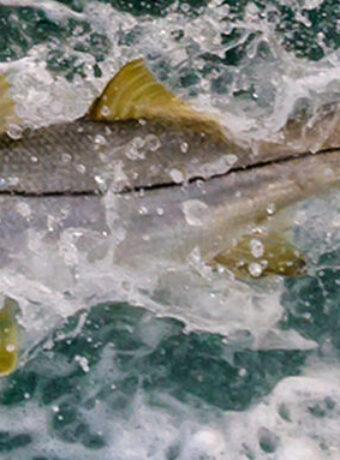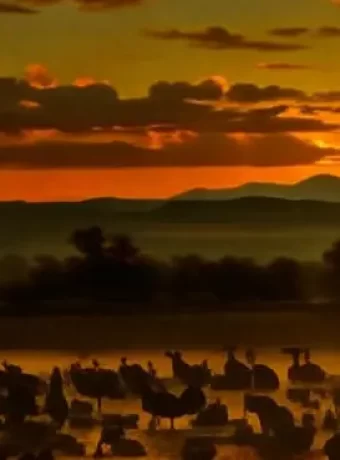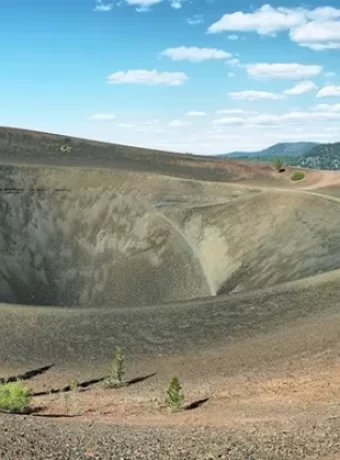Oklahoma Bass Fly Fishing might conjure images of pristine mountain streams teeming with trout, but don’t be fooled. The Sooner State offers a different breed of fly fishing adventure. Imagine yourself wading into the warm waters of a hidden lake, a gentle breeze whispering through the trees, and a fly rod in hand. You’re not after rainbow trout here, but the hard-fighting, acrobatic bass that call these waters home. Oklahoma Bass Fly Fishing is more than just a pastime—it’s a chance to experience the untamed beauty of Oklahoma’s waterways while engaging in a challenging and rewarding pursuit.
Fly fishing for bass in Oklahoma is more than a leisurely pastime; it’s an art. While traditional bass fishing might be more common, there’s something uniquely satisfying about tempting these feisty creatures with a delicate fly. This article explores 15 of the best places to fly fish for bass in Oklahoma, considering both largemouth and smallmouth species, whether you’re a seasoned fly angler or just starting. Because Oklahoma is packed with diverse fisheries from clear mountain streams to vast reservoirs, there’s a perfect fly fishing spot waiting for you.
These best places to fly fish for bass in Oklahoma truly represent the best the state has to offer, covering varied landscapes and fishing challenges. Along the way, you’ll discover why each spot is special, with some tactics to boost your chances of landing that trophy bass.
Table of Contents
Gearing Up for Oklahoma Bass Fly Fishing
Choosing the right gear can make all the difference in your Oklahoma Bass Fly Fishing experience. Unlike trout fishing, which often involves delicate presentations with lighter rods, bass fishing requires a bit more muscle.
Rod and Reel
A fly rod in the 6-8 weight range is ideal for most Oklahoma Bass Fly Fishing scenarios. This weight range provides enough backbone to cast larger flies and wrangle those feisty bass. Pair it with a matching weight-forward floating fly line and a reel with a smooth drag system, and you’ll be ready to tackle anything that swims.
Flies for Oklahoma Bass
Bass are opportunistic feeders, so your fly selection should imitate their preferred forage. Consider these options:
- **Clouser Minnows (Size 2-6)**: These versatile streamers mimic baitfish and can be stripped or retrieved slowly to entice bass.
- **Woolly Buggers (Size 2-6)**: Another classic streamer pattern, the Woolly Bugger, can be fished at various depths and speeds, making it deadly on bass.
- **Poppers (Size 1-4)**: When bass are feeding on the surface, a well-presented popper can create an irresistible commotion, triggering explosive strikes.
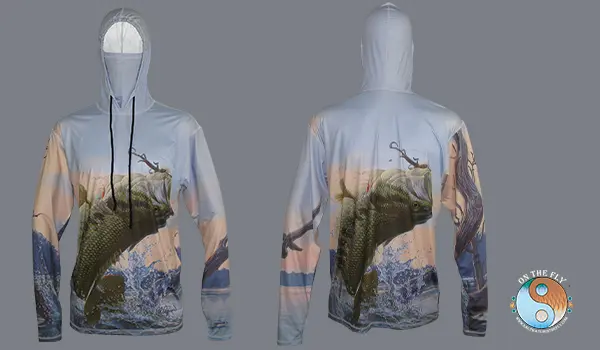
Outdoor Performance Graphic Hoodies
Apparel design for those that love outdoor adventures. Graphic Hoodies to enhance your day on the water. Hands are important and take a beating, Sun Protective Graphic Gloves are a UPF-50 and a extra sewn on stripping guard.

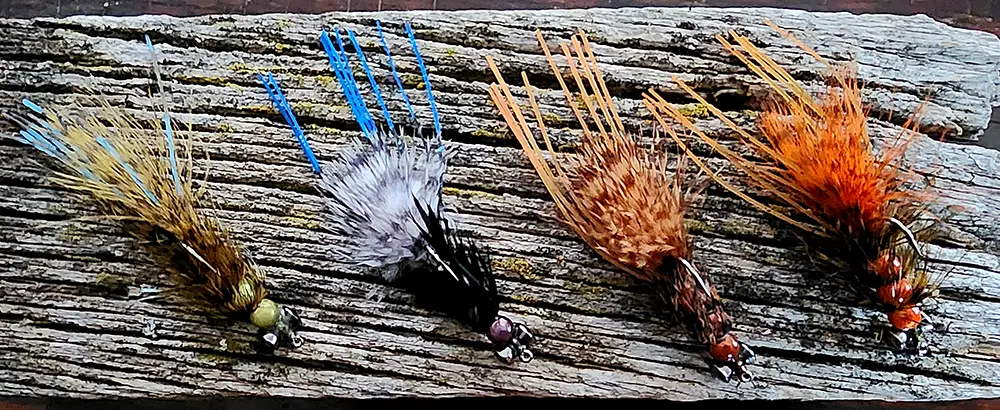
Crayfish and Popper Patterns for Bass
Bass are a fun and challenging species of prey whether Largemouth or smallmouth, all with their unique characteristics. Gotta love crawfish patterns and poppers for great surface activity.
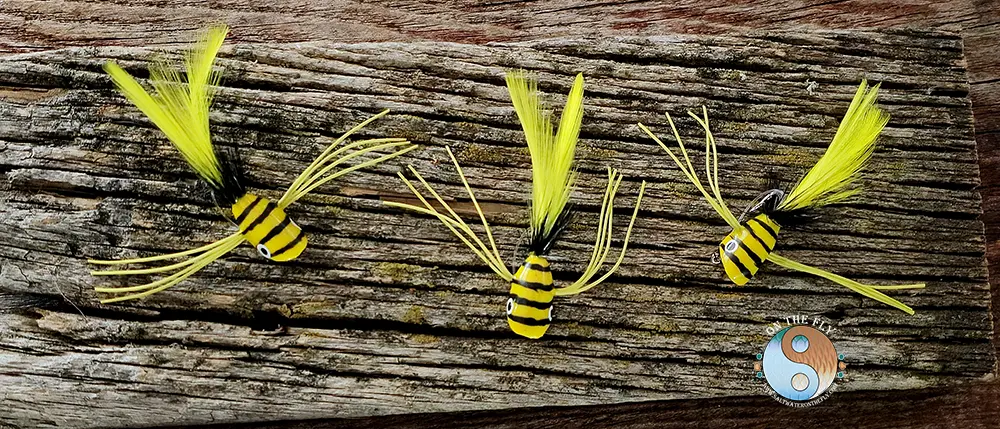
Other Essential Gear:
- **Tapered Leaders**: Use a 7.5-9 foot tapered leader with a tippet size that matches your fly choice.
- **Weight-Forward Floating Fly Line**: A good floating line helps present your flies effectively and allows you to easily see strikes.
- **Polarized Sunglasses**: Help cut through glare on the water, allowing you to spot bass and structure.
- **Wading Boots**: Provide traction and protect your feet while wading in Oklahoma’s rivers and lakes.
When to Fish for Bass
Timing is key in Oklahoma Bass Fly Fishing. While bass can be caught throughout the year, certain seasons offer peak opportunities.
Spring: A Time of Renewal and Aggressive Bites
Spring brings warmer temperatures, causing bass to move into shallower water to spawn. This period of pre-spawn, spawn, and post-spawn creates excellent sight-fishing opportunities.
Summer: Beat the Heat, Find the Bass
As summer’s heat settles in, bass seek cooler water and shade. Target areas with deeper water near drop-offs, ledges, and underwater structure, or fish during the cooler hours of the early morning or late evening.
Fall: Feeding Frenzy Before Winter
As temperatures cool down in the fall, bass go on a feeding spree to fatten up for winter. This creates some of the year’s most exciting fly fishing opportunities, with bass readily striking various flies.
Where to Cast Your Line in Oklahoma
The beauty of Oklahoma Bass Fly Fishing lies in the sheer variety of places to chase these feisty fish. From rivers to lakes and reservoirs, there’s a spot for every angler.
Lakes: Home to Trophy Bass
Oklahoma boasts numerous lakes and reservoirs teeming with bass. Some popular choices include:
- **Lake Texoma (Texas-Oklahoma border)**: This massive lake, straddling the Texas-Oklahoma border, is renowned for its striped bass and offers plenty of opportunities for fly anglers. (Oklahoma Department of Wildlife Conservation)
- **Grand Lake O’ the Cherokees**: With its clear waters and abundant submerged structure, Grand Lake provides a perfect setting for targeting bass on the fly.
- **Lake Tenkiller**: Known for its stunning scenery, Lake Tenkiller boasts a healthy population of largemouth, smallmouth, and spotted bass.
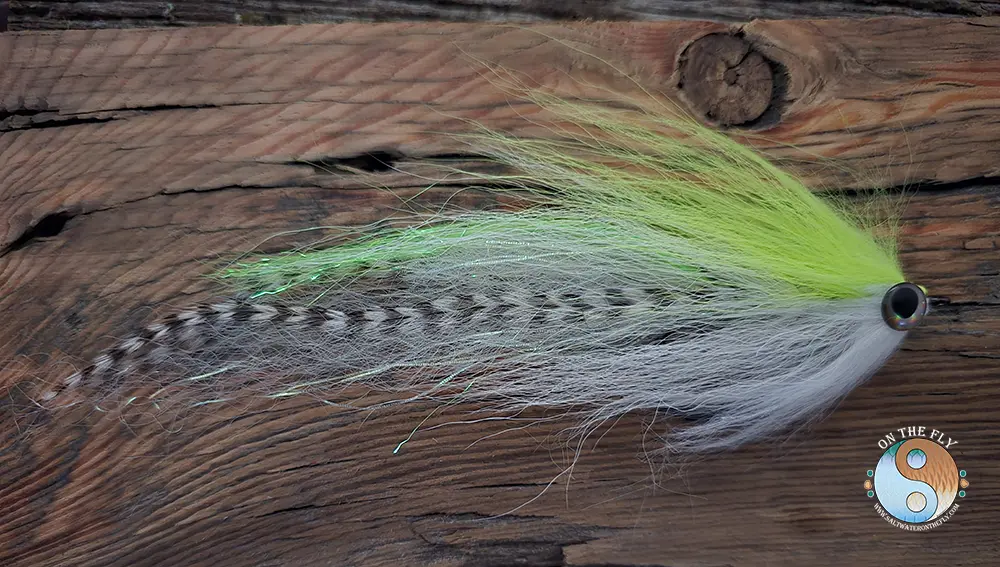
Baitfish Bass Patterns
Having a variety of baitfish patterns is a must for every serious bass fly fisher. The Secret is a great pattern tied on a wide gap hook, make hooking up a bit easier.
Rivers: A Different Kind of Challenge
Oklahoma’s rivers offer a unique fly fishing experience. Try these spots:
- **Lower Illinois River**: Known for its stocked trout population, the Lower Illinois River also holds good numbers of bass, providing an opportunity for multi-species fly fishing.
- **Lower Mountain Fork River**: Another trout stream with resident bass populations, the Lower Mountain Fork offers a beautiful and challenging setting for fly fishing.
- **Glover River**: The clear, spring-fed Glover River meanders through the Kiamichi Mountains, providing excellent habitat for bass. The Glover River is also a great place to spot other wildlife such as wild turkeys.
Fly Fishing Hotspots in Oklahoma
Oklahoma boasts an amazing array of waters suitable for fly fishing, but that sometimes means too many choices. To get you started on your fly fishing adventure, let’s explore some standout locations known for both their beauty and productive bass fishing:
Lower Mountain Fork River
Nestled in southeastern Oklahoma, the Lower Mountain Fork River, or “the Lower Ill,” is renowned for its crystal-clear water, creating an ideal environment for sight fishing. Anglers frequent this tailwater below Broken Bow Lake, targeting both largemouth and smallmouth bass. On a sunny afternoon, I once spotted a sizable smallmouth holding near a submerged log.
With a well-placed size 2 Clouser Minnow in a natural Sculpin pattern, I was rewarded with an aggressive strike and a memorable fight. However, the Lower Mountain Fork River, also known as one of the best trout fishing spots in Oklahoma, isn’t just a summer spot.
This river is stocked regularly with rainbow trout and supports a population of brown trout, providing exciting angling opportunities year-round. I found early mornings to be especially productive during my trip, using size 16-20 Pheasant Tail Nymphs to mimic the aquatic insects the trout were feeding on.
Illinois River
Famed for its scenic beauty and excellent float fishing opportunities, the Illinois River, fed by Lake Tenkiller, also hosts healthy populations of both smallmouth and largemouth bass. Fly fishing here involves covering a lot of water, finding the pockets where bass are actively feeding.
One evening, while casting a Size 2 Bead-head Woolly Bugger in a classic Olive color near a shaded undercut bank, I witnessed an explosive surface strike. The strong current added to the challenge, making for a heart-pumping battle. But don’t limit yourself to bass.
This river also presents anglers with a challenge, thanks to its resident striped bass population. These powerful fish offer an exciting fight for those seeking a more challenging target, especially if you venture downstream into the Lower Illinois River. A common technique among locals is to use large streamers that imitate shad.
Blue River
Flowing through the heart of southern Oklahoma’s Arbuckle Mountains, the Blue River beckons fly anglers with its clear, spring-fed water and healthy population of smallmouth bass. The river’s varied depths and riffles demand a flexible approach to casting and fly selection.
During a summertime float trip, I noticed several smallmouth congregating near a rocky shoal. Using a small, Size 6 Rubber-Legged Hopper and drifting it along the edges of the shoal, I quickly enticed a feisty strike from a bass.
Last Minnow You Will Ever Need
Flies I have the most variations of are, Clouser Minnows and Woolly Buggers.
Lake Eufaula
Bass fly fishing on Oklahoma’s Lake Eufaula can be an exciting and rewarding experience, given the lake’s reputation as a top bass fishery with abundant largemouth, smallmouth, and spotted bass. The key to success lies in selecting the right flies and using effective techniques tailored to the lake’s conditions and the bass’s behavior. Here’s a breakdown of the best flies and how to fish them:
Types of Flies for Bass on Lake Eufaula
- Clouser Minnow
- Description: A versatile, weighted streamer that mimics baitfish like shad, a primary forage for bass in Lake Eufaula.
- Colors: White/chartreuse, olive/white, or gray/white are great choices, as they imitate the lake’s threadfin and gizzard shad.
- Size: #2 to #6 hooks work well, depending on the size of the baitfish present.
- Why It Works: Bass are aggressive predators, and the Clouser’s sinking action and lifelike movement trigger strikes.
- Woolly Bugger
- Description: A classic streamer that resembles leeches, crayfish, or small baitfish.
- Colors: Black, olive, or brown with a flashy tail (e.g., marabou or crystal flash).
- Size: #4 to #8 hooks.
- Why It Works: Its versatility allows it to be fished at various depths, and the pulsating tail attracts bass in the lake’s diverse habitats like brush piles and rocky points.
- Poppers
- Description: Surface flies designed to create noise and commotion, imitating struggling prey like frogs or insects.
- Colors: Black, chartreuse, or white with rubber legs for added action.
- Size: #4 to #8 hooks.
- Why It Works: During warmer months (like now in early April), bass move shallow to feed, and topwater action can be explosive around vegetation or timber.
- Deer Hair Bass Bug
- Description: A buoyant, hair-based fly that floats high and mimics frogs, mice, or large insects.
- Colors: Natural brown, black, or green.
- Size: #2 to #6 hooks.
- Why It Works: Ideal for targeting bass in shallow flats or near cover, especially during low-light periods like dawn or dusk.
- Crayfish Patterns (e.g., Near Nuff Crayfish or Clouser Crayfish)
- Description: Weighted flies that imitate crayfish, a staple in the bass diet.
- Colors: Brown, olive, or rust with realistic claws.
- Size: #4 to #8 hooks.
- Why It Works: Lake Eufaula’s rocky bottoms and ledges are prime crayfish habitat, making these flies effective year-round.
- Baitfish Streamers (e.g., Game Changer or EP Minnow)
- Description: Larger, articulated flies that provide a big profile and lots of movement.
- Colors: White, shad gray, or olive.
- Size: #1/0 to #4 hooks.
- Why It Works: These target trophy-sized bass chasing bigger meals, especially in deeper water or along drop-offs.
How to Fish These Flies
Lake Eufaula’s 105,000 acres offer a variety of habitats—rocky points, shallow flats, standing timber, brush piles, and creek channels—all of which influence how you’ll fish. Since it’s early April 2025, bass are likely in prespawn or spawning phases, focusing on shallow areas with hard bottoms or cover. Here’s how to approach it:
- Clouser Minnow
- Technique: Cast near structure (rocks, timber, or drop-offs) and let it sink a few feet. Use a strip-pause retrieve—short, quick strips followed by a pause—to mimic a wounded baitfish. Vary the speed until you find what triggers strikes.
- Where: Target staging areas like points or creek mouths where prespawn bass gather.
- Woolly Bugger
- Technique: Fish it with a slow, steady retrieve or a twitch-and-pause motion near the bottom. Add a sink-tip line or weighted leader to get it down to bass holding in 5-10 feet of water.
- Where: Brush piles, submerged logs, or rocky shorelines—common Lake Eufaula features.
- Poppers
- Technique: Cast near cover (bushes, docks, or timber) and let it sit for a few seconds after the splash. Then, give it short, sharp pops with pauses in between. Be ready for explosive strikes, especially early or late in the day.
- Where: Shallow flats or shorelines with vegetation, where bass hunt in low light.
- Deer Hair Bass Bug
- Technique: Similar to poppers, but use a slower, subtler “gurgle” retrieve to imitate a frog or mouse. Keep the rod tip low to maintain contact and set the hook quickly.
- Where: Around spawning beds or flooded bushes if the water level is up (check current levels, as 586 feet often triggers great shallow action).
- Crayfish Patterns
- Technique: Bounce it along the bottom with short, jerky strips to mimic a fleeing crayfish. Use a sink-tip line or add split shot to keep it deep. Pause occasionally to let it settle—bass often hit on the drop.
- Where: Rocky flats, ledges, or riprap shorelines, especially on the east side where water is clearer.
- Baitfish Streamers
- Technique: Use long, steady strips with occasional pauses to simulate a fleeing shad. A full sinking line can help reach bass suspended in 10-20 feet of water during warmer days.
- Where: Deeper points, ledges, or open water near shad schools (watch for surface activity or birds).
Gear Tips
- Rod: A 6- to 8-weight fly rod (9 feet) handles most bass flies and Lake Eufaula’s wind.
- Line: Floating line for topwater; sink-tip or intermediate for streamers. A 250-grain full sinking line works for deep water.
- Leader: 8-12 lb tippet (fluorocarbon for subsurface, mono for topwater) to handle aggressive fish and cover.
- Timing: Early April means prespawn or spawn, so focus on mornings and evenings when bass are most active
Seasons of Bass Fly Fishing Lake Eufaula
Fly fishing for bass on Oklahoma’s Lake Eufaula varies significantly across the seasons due to changes in water temperature, bass behavior, and forage availability. The lake’s 105,000 acres, with its mix of shallow flats, rocky points, timber, and creek channels, provide year-round opportunities, but your approach—flies, techniques, and locations—needs to adapt. Here’s a season-by-season guide for targeting largemouth, smallmouth, and spotted bass on the fly:
Spring (March – May)
- Conditions: Water temps rise from 50°F to 70°F+. Bass move shallow for prespawn feeding (March-early April) and spawning (April-May). Lake levels often fluctuate due to spring rains.
- Bass Behavior: Aggressive prespawn feeding, followed by bedding activity in 2-8 feet of water.
- Flies:
- Clouser Minnow (#2-#6, white/chartreuse or olive): Mimics shad, a key prespawn food.
- Crayfish Patterns (#4-#8, brown or olive): Bass gorge on crayfish near rocky spawning areas.
- Poppers (#4-#8, black or chartreuse): Topwater action heats up as temps climb.
- Woolly Bugger (#4-#8, black or olive): Versatile for staging fish.
- Techniques:
- Prespawn (March-early April): Target staging areas—points, creek mouths, and drop-offs—with streamers. Use a sink-tip line and a strip-pause retrieve to mimic wounded baitfish or fleeing crayfish.
- Spawn (April-May): Fish shallow flats, coves, and gravel banks near cover. Cast poppers or unweighted crayfish flies near beds (avoid snagging bedding fish directly if you’re catch-and-release). Slow twitches or a dead drift work best.
- Where: Eastern clearer waters, rocky shorelines, flooded bushes (if levels rise above 585 feet), or creek arms like Gaines or Deep Fork.
- Tip: Early mornings and late afternoons are prime as bass feed heavily before and after spawning.
Summer (June – August)
- Conditions: Water temps hit 75°F-90°F. Bass move deeper post-spawn but return shallow to feed at dawn/dusk. Vegetation thickens, and shad schools proliferate.
- Bass Behavior: Post-spawn recovery early, then aggressive feeding on shad and surface prey. They school up or hold near structure.
- Flies:
- Poppers (#4-#6, white or black): Explosive topwater bites in low light.
- Deer Hair Bass Bug (#2-#6, natural colors): Great for shallow cover.
- Game Changer (#1/0-#2, white or shad): Big profile for deeper fish chasing shad.
- Clouser Minnow (#2-#6, gray/white): Matches shad schools.
- Techniques:
- Topwater: Cast poppers or bass bugs near timber, docks, or weed edges at dawn/dusk. Use sharp pops with long pauses—wait for the boil before setting.
- Subsurface: Use a full sinking line (250-300 grain) or sink-tip to get streamers 10-20 feet deep along ledges, points, or humps. Long, steady strips mimic fleeing shad.
- Where: Main lake points, deep brush piles, standing timber, or open water near shad (watch for birds). Shallow flats early/late in the day.
- Tip: Fish early or late to avoid midday heat. Look for shade under docks or trees where bass ambush prey.
Fall (September – November)
- Conditions: Water cools from 80°F to 55°F. Shad migrate into creeks, and bass follow. Turnover may muddy water briefly.
- Bass Behavior: Feeding frenzy as bass bulk up for winter. They chase baitfish aggressively in shallow and mid-depth zones.
- Flies:
- Clouser Minnow (#2-#6, white/chartreuse or olive): Perfect for shad-heavy areas.
- EP Minnow (#2-#4, shad or perch colors): Big, flashy baitfish imitation.
- Woolly Bugger (#4-#8, black or brown): Works near bottom structure.
- Poppers (#4-#8, chartreuse or black): Still effective in early fall.
- Techniques:
- Streamers: Cast to creek mouths, points, or flats where shad congregate. Use an intermediate or sink-tip line with erratic strips to mimic panicked baitfish.
- Topwater: Early fall still offers topwater action—poppers near cover or schooling fish. Switch to subsurface as water cools.
- Where: Creek channels (e.g., North Canadian or Deep Fork arms), windblown banks, or flats near baitfish schools. Rocky points hold smallmouth.
- Tip: Follow the shad—bass will be nearby. Windy days concentrate bait and fish on one side of the lake.
Winter (December – February)
- Conditions: Water temps drop to 40°F-50°F. Lake levels may stabilize or drop. Bass slow down but still feed sporadically.
- Bass Behavior: Lethargic, holding in deeper water (10-25 feet) near structure or channels. They feed on slow-moving prey like crawfish or dying shad.
- Flies:
- Crayfish Patterns (#6-#8, brown or olive): Slow, bottom-hugging presentation.
- Woolly Bugger (#6-#10, black or olive): Subtle movement for sluggish bass.
- Clouser Minnow (#4-#8, white or olive): Smaller sizes for finesse fishing.
- Techniques:
- Subsurface: Use a full sinking line (300 grain) to get flies deep. Fish painfully slow—long pauses with tiny twitches or a dead drift near the bottom. Let the fly sit for 5-10 seconds between strips.
- Jigging: Bounce crayfish patterns along rocky bottoms or ledges like a jig.
- Where: Deep points, creek channel edges, submerged humps, or brush piles in 15-25 feet. Smallmouth favor rocky areas near the dam.
- Tip: Midday can be best as water warms slightly. Patience is key—strikes are subtle, so watch your line for movement.
General Gear Recommendations
- Rod: 6- to 8-weight, 9-foot fly rod. Use 8-weight for big streamers or windy days.
- Line: Floating for topwater; sink-tip (150-250 grain) for shallow subsurface; full sinking (250-350 grain) for deep water.
- Leader/Tippet: 8-12 lb test. Fluorocarbon for subsurface stealth; mono for topwater buoyancy.
- Timing: Low-light periods (dawn/dusk) are prime in spring/summer/fall. Winter favors midday warmth.
Lake Eufaula Notes
- Water Levels: Check USACE updates—above 585 feet floods shallow cover, below 583 feet exposes structure. Adjust accordingly.
- Weather: Spring and fall storms can muddy water; target clearer inflows or the east side.
- Forage: Shad dominate, but crayfish, bluegill, and frogs matter too—match your flies to what’s active.
By tailoring your flies and techniques to the season, you’ll maximize your chances of hooking Lake Eufaula’s bass. Each season offers a unique challenge, so experiment with retrieves and locations to dial in what the fish want that day. Tight lines!
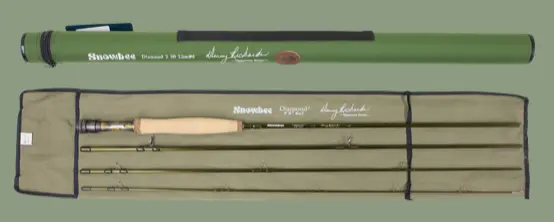
A nine foot six weight designed to throw streamers all day long. Absolutely a great bass fly rod.
Grand Lake O’ the Cherokees
Locally known as Grand Lake, this reservoir holds diverse bass habitat, from rocky points and submerged timber to grassy flats. The sheer size of the lake offers a great advantage for fly anglers, as boat traffic tends to disperse.
During my spring trip, focusing on shallow coves where bass were staging for the spawn proved successful. Cast a weedless 3-inch Zoom Fat Albert Grub in Watermelon Red Flake to entice aggressive strikes. Grand Lake is a massive reservoir, the third largest in Oklahoma with 46,500 surface acres.
I noticed this made breaking the lake down into sections, targeting creeks and rivers, essential. Many houses for rent and resorts dot the shoreline making it a great spot for a fishing getaway.
Broken Bow Lake
Located in southeastern Oklahoma, Broken Bow Lake impresses anglers with consistently good bass fishing year-round, housing largemouth and smallmouth, some reaching trophy size. The lake’s varying depths and submerged structures create exciting challenges for fly anglers.
Try casting a 1-7/8 inch Heddon Tiny Torpedo in Brown Crawdad to mimic the crawfish that abound in the lake, working it near drop-offs and rocky points. Broken Bow, with 14,000 acres of surface, consistently ranks high on angler lists.
On my recent trip, focusing on points and areas with downed timber near deep water consistently produced good results, particularly in the early mornings. But don’t forget about the excellent trout fishing opportunities below the lake in the Mountain Fork River flowing through the breathtaking Beavers Bend State Park. It’s an excellent location for both brown trout and rainbow trout.
Tenkiller Ferry Lake
Also known as Tenkiller, this pristine lake stands out with clear water. Tenkiller consistently yields good smallmouth and largemouth bass, attracting fly anglers looking for visual fishing. Cast a Size 2/0 to Size 6 jig or bead-head fly in black near submerged vegetation and along rocky shorelines to target these feisty fish.
Tenkiller is Oklahoma’s fifth-largest lake, providing ample space and options for those seeking solitude and great fishing. With two introduced trout streams flowing into it, the Lower Illinois River and the Lower Mountain Fork River, there’s a reason seasoned anglers frequent these waters. Whether from a boat or wading along the banks, Tenkiller’s scenery is a constant treat.
Lake Thunderbird
Located just south of Oklahoma City, Lake Thunderbird is a popular bass fishing destination. Its numerous coves and inlets offer diverse habitat, perfect for fly anglers. Although the lake can get busy during peak seasons, it’s worth exploring for its quality bass fishing.
Cast a 1.5-inch Bass Pro Shops Tournament Series Squirmin’ Squirt Tube in Green Pumpkin Red Flake with a 1/32nd ounce Bass Pro Shops Squirt Head for a successful outing.
Lake Murray
Nestled in the heart of southern Oklahoma, Lake Murray offers good fly fishing opportunities, especially for beginners. Its clear water allows for visual fishing, making it a rewarding spot to try sight-casting to bass.
While this lake boasts ample shoreline, renting a boat allows exploration of the best coves and fishing spots. Target these fish near creek mouths and flooded timber with topwater flies for exciting surface strikes, especially during warmer months.
Lake Hefner
Situated in Oklahoma City, Lake Hefner provides a convenient option for fly fishing. It’s known for its relatively clear water and solid bass populations. While shoreline access is somewhat limited, this urban lake is worth exploring, meaning fishing from a kayak can be highly rewarding.
Remember, you might have to contend with heavy boat traffic. Early mornings or weekdays are often your best bet for less congested fishing. Cast near the rocky shoreline edges for the best chances.
Lake Arcadia
Another option near Oklahoma City, Lake Arcadia holds a variety of fish species, including catfish. This well-maintained lake attracts both boat and bank anglers. Try focusing on the deeper, rocky sections of the lake for bass.
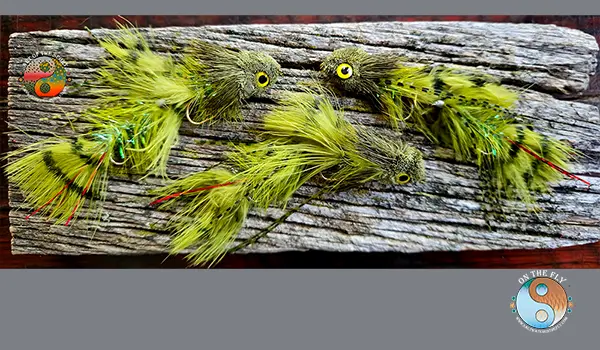
Another fun streamer to use fly fishing for bass is a dungeon. This is an articulated pattern adding to action and getting pounced on by largemouth.
Lake Texoma
Bass fly fishing on Oklahoma’s Lake Texoma is a fantastic pursuit, thanks to the lake’s thriving populations of largemouth, smallmouth, and spotted bass. Spanning 89,000 acres across the Oklahoma-Texas border, this massive reservoir offers diverse habitats—rocky bluffs, creek arms, brush piles, and open water—that dictate fly choice and fishing techniques. Here’s a guide to the best flies and how to fish them for bass on Lake Texoma.
Types of Flies for Bass on Lake Texoma
- Clouser Minnow
- Description: A weighted streamer with a slim profile, designed to mimic baitfish like shad, a dominant forage in Texoma.
- Colors: White/chartreuse, gray/white, or olive/white.
- Size: #2 to #6 hooks.
- Why It Works: Its sinking action and lifelike movement make it irresistible to bass ambushing shad near structure or in open water.
- Woolly Bugger
- Description: A versatile fly with a marabou tail and hackle, resembling leeches, small baitfish, or crayfish.
- Colors: Black, olive, or brown with flash in the tail.
- Size: #4 to #8 hooks.
- Why It Works: The pulsating tail and adaptability to various retrieves appeal to bass in diverse habitats like creeks or rocky shorelines.
- Poppers
- Description: Floating flies with a cupped face to create surface disturbance, imitating frogs, insects, or struggling baitfish.
- Colors: Black, white, or chartreuse with rubber legs.
- Size: #4 to #8 hooks.
- Why It Works: Topwater action excels in shallow areas during warmer months, triggering explosive strikes from aggressive bass.
- Deer Hair Bass Bug
- Description: A buoyant, hair-based fly that floats high, mimicking frogs or mice.
- Colors: Natural brown, black, or green.
- Size: #2 to #6 hooks.
- Why It Works: Perfect for targeting largemouth in shallow coves or near vegetation, especially at dawn or dusk.
- Crayfish Patterns (e.g., Near Nuff Crayfish or Clouser Crayfish)
- Description: Weighted flies with claws and a realistic profile, imitating crayfish—a key bass food source.
- Colors: Brown, olive, or rust.
- Size: #4 to #8 hooks.
- Why It Works: Smallmouth and spotted bass, prevalent near rocky areas, can’t resist these bottom-dwellers.
- Baitfish Streamers (e.g., Game Changer or EP Minnow)
- Description: Larger, articulated flies with a big profile and lots of movement, mimicking shad or bluegill.
- Colors: White, shad gray, or olive.
- Size: #1/0 to #4 hooks.
- Why It Works: Ideal for targeting bigger bass in deeper water or chasing schooling shad.
How to Fish These Flies
Lake Texoma’s bass respond to seasonal patterns and habitat, so your approach depends on where and when you’re fishing. As of April 3, 2025, spring conditions (water temps 50-65°F) mean bass are in prespawn or spawning mode, favoring shallow zones. Here’s how to fish each fly type:
- Clouser Minnow
- Technique: Cast near drop-offs, points, or creek channels and let it sink 5-15 feet (use a sink-tip line). Retrieve with short, erratic strips followed by pauses to mimic a wounded shad. Vary depth and speed until you find the strike zone.
- Where: Main lake points (e.g., Platter Flats), creek mouths, or submerged humps where bass stage before spawning.
- Woolly Bugger
- Technique: Fish it slow and low with a sink-tip or intermediate line. Use a steady retrieve with occasional twitches, or let it drift near the bottom. Add weight if needed to reach 5-10 feet.
- Where: Brush piles, rocky shorelines near Eisenhower State Park, or creek arms like Hickory Creek.
- Poppers
- Technique: Cast to shallow cover (docks, timber, or grass) with a floating line. Let it sit after the splash, then pop it sharply with 2-3 second pauses. Strikes often come on the pause—be patient.
- Where: Coves, shorelines near Lake Texoma State Park, or shallow flats during low-light hours.
- Deer Hair Bass Bug
- Technique: Similar to poppers, but use a subtler “gurgle” retrieve to imitate natural prey. Keep the rod tip low for a quick hookset. Fish it slow near spawning beds or cover.
- Where: Shallow spawning areas in creek arms (e.g., Washita River arm) or flooded vegetation if levels rise above 617 feet.
- Crayfish Patterns
- Technique: Bounce it along the bottom with short, jerky strips using a sink-tip line or split shot. Pause to let it settle—bass often hit on the drop. Fish it like a jig near rocky structure.
- Where: Rocky bluffs near Denison Dam, riprap banks, or smallmouth habitat in the Washita arm up to Willow Springs.
- Baitfish Streamers
- Technique: Use a full sinking line (250-300 grain) for depths of 10-20 feet. Long, steady strips with occasional pauses mimic fleeing shad. Watch for surface activity to locate schools.
- Where: Open water near shad schools, main lake points, or deeper ledges when bass push offshore post-spawn.
Gear and Seasonal Tips
- Rod: 6- to 8-weight, 9-foot rod. Use 8-weight for bigger streamers or windy conditions (common on Texoma).
- Line: Floating for topwater; sink-tip (150-250 grain) for shallow streamers; full sinking (250-350 grain) for deep water.
- Leader: 8-12 lb fluorocarbon for subsurface; 10-15 lb mono for topwater. Bass here aren’t leader-shy.
- Spring (Now): Focus on shallow water (2-10 feet) near spawning sites—gravel banks, coves, or creek inlets. Prespawn bass hit streamers hard; spawning fish favor topwater or crayfish flies near beds.
Hotspots on Lake Texoma
- Largemouth: Creek arms (Hickory, Lebanon), Washita Point, and shallow coves with brush or docks.
- Smallmouth: Rocky bluffs near Denison Dam, Eisenhower State Park, and the Washita arm up to Willow Springs.
- Spotted Bass: Main lake points and transitional zones between rocky and sandy bottoms.
Final Thoughts
In early April, Texoma’s bass are active and shallow, making it prime time for fly anglers. Match your fly to the forage—shad, crayfish, or surface prey—and adjust your retrieve to the bass’s mood. Watch for shad schools or diving birds to pinpoint feeding zones. With its size and diversity, Texoma rewards experimentation, so don’t hesitate to switch flies or tactics until you crack the code. Enjoy the fight—these bass pull hard!
Skiatook Lake
Skiatook Lake, a scenic lake located north of Tulsa, also holds healthy populations of largemouth and smallmouth bass. Its rocky bluffs, submerged timber, and expansive shoreline attract anglers. Target brush piles and submerged structures with a fly that mimics crayfish for success.
Kaw Lake
A popular choice for bass fishing, Kaw Lake is located in northern Oklahoma. This lake has public access for all. The rocky points and riprap along the shoreline and near bridges provide prime fly fishing opportunities for largemouth.
FAQs About the 15 Best Places to Fly Fish for Bass in Oklahoma
Where is the best bass fishing in Oklahoma?
The “best” spot is subjective. While some locations consistently yield great catches, factors like the species, preferred fishing techniques, time of year, water clarity, and experience influence your ideal location. You may even have luck bank fishing.
What lake in Oklahoma has the biggest bass?
Many anglers have set their sights on Broken Bow Lake due to its impressive track record of trophy-sized largemouth bass. Check out the list of the top 20 biggest largemouth bass caught in Oklahoma. Many anglers, myself included, have seen Broken Bow Lake mentioned time and again.
Not only are the fish huge, there’s lots of ’em. It produces not only big fish but a surprising number of big fish. Don’t forget, it also harbors impressive smallmouth bass.
Where is the best place to catch smallmouth bass in Oklahoma?
While several locations boast strong smallmouth bass populations, the clear, flowing waters of the Lower Mountain Fork River and the Blue River often rise to the top of fly anglers’ lists. However, Lake Lawtonka also boasts record-breaking smallmouth catches.
When should I fly fish for bass?
Each season in Oklahoma brings unique challenges and opportunities for fly anglers. You’ll need to adjust your strategies to align with water temperatures and fish behavior.
For many bass species, late spring and early fall generally provide optimal fishing conditions. These are typically periods of moderate temperatures, increased fish activity, and prime feeding behaviors.
Conclusion of Oklahoma Bass Fly Fishing
These 15 best places to fly fish for bass in Oklahoma aren’t just locations on a map; they’re potential chapters in a lifelong angling adventure. From quiet morning casts on serene streams to exhilarating battles against hefty bass, fly fishing in Oklahoma has much to offer, with scenic beauty accompanying fantastic catches. Each destination has personality and a set of challenges unique to the location. So pick your spot, prepare your gear, and start creating your fly fishing stories in Oklahoma.



